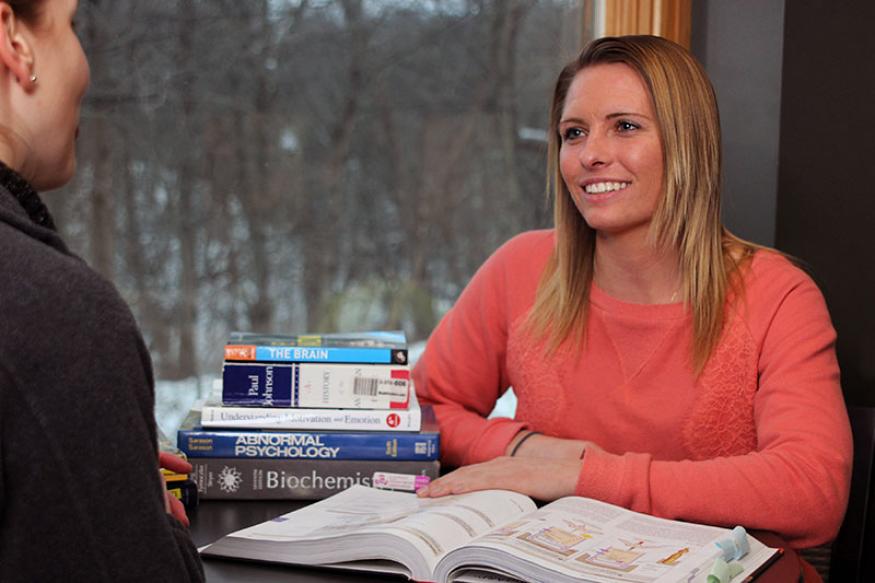
Connecting interests leads Rakers down memorable path
Kendra Rakers ’16 is interested in memory and how it works, particularly as it relates to Alzheimer’s disease. So she chose an interdisciplinary major in neuroscience with minors in biochemistry and history. Fueled by a fascination with human memory, Kendra Rakers combined a variety of disciplines to examine her interest from several perspectives. It’s a perfect fit, she says, because each field approaches memory from a different point of view, which is a good way to provide more flexibility in her career. As she sees it, “I’ll probably wind up with a job that hasn’t been invented yet.”
Rakers’ multi-dimensional approach to education is certainly a classic description of the liberal arts, but it also helps to explain why graduates from liberal arts colleges, including Augustana, are gaining recognition for their ability to adapt to change.
“It’s looking at complex problems creatively,” said Dr. Pareena Lawrence, provost of Augustana. “Understanding the context of these problems, how they interact with and impact society from multiple perspectives, and then designing creative solutions that are both thoughtful and comprehensive.”
Or, as Dr. Dara Wegman-Geedey puts it, “As the world gets more connected, the liberal arts matter more.”
Dr. Wegman-Geedey is the biology professor who helped design Augustana's new public health major, the latest of seven majors that are considered “interdisciplinary,” meaning they draw content from two or more disciplines. Public health can be approached through anthropology, biology, philosophy or statistics, to name a few. It's also become one of the fastest-growing fields of postgraduate work — and employment, according to the U.S. Department of Labor.
Rakers chose neuroscience as an interdisciplinary major because it combines biology and psychology, both related to memory. She then took an even wider view by adding biochemistry and history. That’s because memory is personal history, she said, and biochemistry can help her with laboratory research to determine how memory is lost with Alzheimer’s disease.
“I’m very interested in how memory changes as we age,” Rakers said. “A lot of history is conveyed through oral presentations and stories, which are based so much on memory.”
Ideally, she said, in 10 years, she will be a memory researcher in a lab-based setting, with a focus on Alzheimer's. It all fits.
“Understanding these connections, based on a wide-ranging education, is such a natural idea,” Rakers said. “For example, history is just like science. It’s just a different kind of research, and it has made me a better problem solver, which is a critical skill in any laboratory setting.
“I think we’ve always had more of a narrow view, so that if you want this job, you specialize in this field to get there. Now, I think we've reached the point where we're thinking about careers in a different way.”
Will Rakers wind up with a job that hasn’t been invented yet? That question is actually being tracked by employers and the U.S. Department of Labor as careers undergo a rapid metamorphosis to accommodate 21st-century technology and social trends. What students learn today may change tomorrow.
Students will need broader skill sets that allow them to adapt more quickly to change. They must learn how to think, rather than what to think. And critical thinking skills, a hallmark of the liberal arts approach, have become essential, especially for employers that emphasize entrepreneurship and innovation.
A recent article in Forbes magazine suggested that a liberal arts education is emerging as one of the best assets for employment in Silicon Valley, where creative thinking is prized.
“I think one of the main benefits of an interdisciplinary major is that well-roundedness and open-mindedness make you a more mature learner, in general,” said Rakers, “and that's a job skill in itself.”
Connecting the dots between different disciplines has led Augustana to adopt more interdisciplinary majors. Not only are they designed for a future that has become more fluid, they also follow the interest of students who want more flexibility.
"A lot of the exciting research is happening in the spaces where disciplines are intersecting and uncovering new ground,” Dr. Lawrence said. “In some cases, it’s building entirely new fields. Taking a broader outlook can offer a better fit for some students, by letting them look at the big picture through a different lens.”
